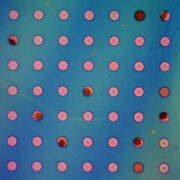- Companies like Lululemon, Disney, and Tesla are creatively using rooftop solar arrays in their branding strategy.
- These installations not only provide renewable energy but also serve as unique visual statements.
- The solar panel arrangements make logos visible from the sky, showcasing corporate commitment to sustainability.
In a world where sustainability and corporate identity intertwine, a new trend is emerging among forward-thinking companies: rooftop solar arrays that not only power their operations but also proudly display their logos.
This unique approach to branding not only reinforces a commitment to renewable energy but also transforms rooftops into captivating canvases visible from space.
Let’s explore how these innovative companies send a powerful message of environmental responsibility while making their logos part of the sky-high landscape with rooftop solar arrays.
1. Lululemon
Known for its athletic apparel, Lululemon has embraced renewable energy with a rooftop solar installation that creatively integrates its logo. Lululemon’s logo is now visible from the skies, thanks to an innovative rooftop solar installation on one of its warehouses in British Columbia.
The panels are arranged to mirror the company’s distinctive branding, turning the rooftop into a striking display. Lululemon’s solar panel arrangement is the largest solar energy system in the province, as confirmed by Wesgroup Properties, the developer responsible for both the warehouse and the panel setup for the prominent West Coast fashion brand.
Comprising a total of 2,592 panels situated atop a Delta, B.C. warehouse, the complete array boasts a capacity of 1.2 megawatts.
This collective energy output is equivalent to the annual energy consumption of nearly 100 homes in British Columbia or the energy required for a Tesla Model 3 to cover an astounding 6.6 million kilometers.
2. Disney
Disney’s solar branding showcases the company’s knack for storytelling even in its sustainability initiatives.
In true Disney fashion, the installation takes on the recognizable shape of Mickey Mouse’s iconic head. Comprising an impressive 48,000 panels, this mouse-shaped solar array is projected to generate five megawatts of energy, according to Duke Energy, the company responsible for its construction.
This energy output equates to the capacity of approximately 1,000 residential rooftop solar systems working in tandem. The rooftop solar array isn’t Disney’s first time ingeniously incorporating “hidden” mouse silhouettes within the vicinity of the park to underscore its commitment to sustainability.
In 1992, Disney planted 60,000 trees to form the Mickey Mouse Forest, which is visible from Google Earth. Both projects align with Disney’s ongoing efforts to minimize their carbon footprint and align Disney’s brand with sustainability.
3. Target
Retail giant Target has joined the solar branding trend with two distinctive solar arrays resembling its well-known bull’s-eye logo.
These installations not only power their operations but also visually communicate Target’s commitment to green practices. In 2017, Target proudly presented its most expansive solar array to date, situated atop the distribution center in Phoenix—an installation notable not only for its size but also for its unique adaptation of the company’s iconic logo.
Generating nearly 3,000 megawatt-hours of energy annually, this solar array effectively combines sustainability with branding. Adding to its allure, its strategic location adjacent to Phoenix Sky Harbor International Airport ensures that its distinctive bullseye configuration remains visible to those arriving from the western skies.
4. SpaceX
Elon Musk’s aerospace company, SpaceX, combines innovation and sustainability by incorporating its logo into rooftop solar panels.
The “X” formed by solar arrays on the roof of SpaceX Headquarters is a testament to the company’s pioneering spirit. Resembling an environmentally conscious version of the Bat Signal, the rooftop solar panel setup adorning the SpaceX rocket factory pays homage to CEO Elon Musk’s terrestrial endeavors in diminishing our dependency on fossil fuels.
These panels yield an impressive 1 megawatt of power—equivalent to approximately 900 times the output of a standard residential solar installation.
The array was expertly installed by SolarCity, the nation’s largest solar installation company, notably under the leadership of Elon Musk’s cousin, Lyndon Rive. It’s worth noting that Musk holds the position of chairman on the SolarCity board of directors, further underlining his commitment to renewable energy initiatives.
5. Tesla
Always at the forefront of innovation, Tesla has turned its Gigafactory rooftop in Texas into a branding canvas. By arranging solar panels in negative space, Tesla spelled out “T E S L A,” showcasing its dedication to clean energy and creative branding.
Tesla’s ambitious solar project in Giga Texas aims to break records for the largest rooftop solar installation globally.
This monumental endeavor not only aligns with Elon Musk’s vision but also presents a grand branding opportunity visible from space. The facility’s sheer enormity and ample rooftop expanse made it the perfect backdrop for Tesla to embark on a large-scale installation of solar panels.
In Tesla’s 2020 Impact Report, the company highlighted the implementation of 3.2MW of solar panels at Gigafactory Nevada. Since then, further expansions have ensued, with Tesla envisioning the culmination of a robust 24MW solar panel infrastructure at Gigafactory Nevada by year’s end.
Spot the Logo
The sky’s the limit for companies using rooftop solar arrays as innovative branding tools, merging sustainability with visual identity. Businesses are sending a message of environmental responsibility while making their logos part of the landscape visible from the sky and even from space.
In a few years, maybe we’ll be able to play “spot the logo” every time we hop into a plane.












Comments